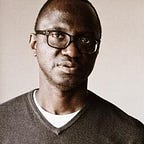What is significant?
‘Who Do You Think You Are?’
Ugoma Adegoke and I recently had a discussion about how to embody a space of cultural nuance; inspired by African literary and cultural movements: led by a generation of African creatives “offering an expansive perspective on the visual arts of the continent” — ‘New currents, ancient river, contemporary African artists in a generation of change’, Jean Kennedy, 1992, Book Jacket. The idea is under consideration by Ugoma and project sponsors, as a place where multidisciplinary creatives, scientists, engineers and technologists explore interdisciplinary overlap: to re-frame cultural nuance.
Her network of literary artists, creative partners and sponsors who provide support for sense making across proverbial boundaries are key to this inspiration. Ugoma founded Lights, Camera, Africa (LCA) in 2011, an annual film festival held in Lagos. She serves as its executive director.
“Transforming ideas on paper and in your heart to reality always takes some sacrifice and is usually quite painful” — Ugoma Adegoke
To my mind, issue driven narratives and her network underscore both the space under consideration and screening formats at LCA. These are platforms for issue driven narratives where participants view, feel, make their minds up, challenge and re-frame each other’s views. As a consequence a common thread runs through our thoughts: how do we better listen to our audience and ourselves in order to invite people to look at and see ‘Who Do You Think You Are?’ It is a shorthand, for a complex issue.
This shorthand asks us to piece together a reflective narrative; connection with our psychological portraits in relation to those of others; from our cultural references; real and reconstructed memories, aspirations, sense of belonging, tightness or looseness relative to social norms; deeply rooted mindsets; states of mind at various moments, that bring out the best or worst in us and how we (un)calcify stereotypes — internationally, as nations, communities and individuals.
Interpretation of a shorthand
This brings us to photography, particularly its ability to find surrealism in mundane moments or capture scene action from a face in the crowd.
I take time out from design thinking to get behind the lens at Africa Utopia: an annual festival which celebrates Africa’s arts and culture at the Southbank Centre, London, where I immerse myself in the festival’s passing parade. At an intersection by the main foyer in the Royal Festival Hall, I stay awhile waiting for the right person to come into view.
Behind the viewfinder “enclothed cognition” waltzes into my thoughts. I found this curious tidbit in the New York Times; “the systematic influence that clothes have on the wearer’s psychological processes,” meaning what your clothes are saying to you, not about you. And how they make you feel, think and act.
Just then Bibi Moyo appears in my field of view. She beelines for accessory stalls across the fashion market. As her expressive aesthetic comes into view so does a geometric metaphor for our shorthand: How curious to consider, a mélange of Topotha beaded hats, Ndebele architectural murals, Kente motifs and Masai beadwork on someone’s body, as likely migratory influences; in the story they provide to the wearer and viewer. I am about to get a snapshot.
I pan around her to ensure she walks into, away from and across the viewfinder’s frame as she browses items in ways that steal a gaze. It is necessary that one makes a photograph that, in that particular moment, tells a story. In my view the most compelling photo stories are suggestive. Even better when they prompt viewers to contemplate and question what it is they are looking at. I introduce myself to Bibi, we discuss consent and make small talk. We did not have enough time in which to chat about her creative and production processes, beyond her snapshot story: she is an accessories designer, who wears her own collection, stands out and stands up for her provenance. I would later, whilst writing this piece, check her out at Instagram. I see and read enough to sense that her mixed heritage and travel lend a visual voice to her work.
Testing vital elements and building blocks, for preferences
As a design practice that is people research centred, a logic framework with an evidence base, reason and creativity informs prototype generation and validation. This approach applies to print visuals, moving image, physical artefacts, digital: content, service, technology and platform. An audience sample, the project team, Blessing Abeng (project manager), Amaka Okolo, Lanre Shasore,Ugoma Adegoke, Angela Lyons,Caroline Deeds and I co-preview diverse combinations of photographs, words, colourways, tones and typographic treatments as a whole: inspired by the geometric metaphor I referred to earlier. We get back to WhatsApp to narrow down our options until we feel clear about the direction we are headed in.
The placement of ellipses rotating on an axis over Bibi’s eye is designed to draw the viewer’s attention to a masked riddle. It is framed by a montage of typographic focal points and geometric patterns, with vivid colours. This montage is an invite, for attention. It is a versatile work horse, set up to play multiple audience test and interface roles, from cinema sequence, discussions, pop-up performance, landscape, physical artefacts to print and digital patterns and user interface coherence.
This masked riddle speaks to this year’s theme as a prompt for conversations around socially constructed boundaries; world views which contribute to our self-concept. This reality will occupy screen narratives and discussions at this festival.
All things being equal, Ugoma and I will continue our conversation, where we left off, about spaces that embody cultural nuance; inspired by African literary and cultural movements.
What i find significant about these projects; they are a culmination of conversations, ambiguity and a collaborative effort to interpret and test imaginative intent.
A mirror check: Who is this person? What do i stand for? How much do we notice the norms around us and the expectations that people have of us and we of them?
